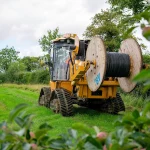All Public 2G and 3G UK Mobile Services Switched Off by 2033

The Government has unveiled a new agreement with the four primary mobile network operators, including Vodafone, EE (BT), O2 (VMO2) and Three UK, which among other things will see existing 2G and 3G signals being “phased out” by 2033 (benefitting 4G / 5G services and mobile broadband) and a new target for OpenRAN adoption.
The idea of switching off older 2G and 3G networks is hardly new or surprising, particularly since today most of us make calls and surf the internet via faster 4G and 5G networks. Not only does such a switch-off save money and cut power consumption, but the spectrum can then be re-farmed for use by the latest technologies (i.e. not just 4G and 5G, but also future 6G), which will help to improve coverage and service speeds for consumers.
However, contrary to what you might think, most mobile operators tend to expect 3G to be phased out before 2G because the latter remains useful as a low-power fall back and is still necessary for some rural areas, as well as for particular applications. For example, quite a few early Smart Meters and other Internet of Things (IoT) / M2M services are still dependent upon 2G.
Advertisement
The government has now agreed with the UK mobile network operators (MNOs) that 2033 “will be the date by which all public 2G and 3G networks in the UK will be switched off“, although it should be said that some operators will reach this point before that date. For example, EE plans to retire older 3G (this currently represents just 2% of data traffic over their network) by the end of 2023.
Hamish MacLeod, Director of Mobile UK, said:
“Mobile UK and its members welcome the government’s statement. Switching off 2G and 3G will enable operators to transition fully to more energy efficient and high capacity networks to the benefit of customers. We are also working with government and wider industry to support the maturity of new RAN solutions to open up further opportunities for innovation and new services in the future.”
A Stronger Focus on OpenRAN
On top of the aforementioned sunset for 2G and 3G services, the Government and mobile operators have also announced new plans to boost innovation and accelerate the rollout of the new Open Radio Access Networks (Open RAN) technology. Under this plan, a “joint ambition” has been set that will see 35% of the UK’s mobile network traffic being carried over OpenRAN by 2030.
At present, most UK mobile operators can often only pick from a couple of major suppliers (e.g. Nokia, Ericsson) to help deploy their networks, which wasn’t helped by the Government’s decision to ban Huawei from 5G (also impacting 4G) over security fears.
The O-RAN approach could help this situation by standardising the design and functionality of such radio access kit and software (the RAN side covers infrastructure, masts and antennae), which could increase the number of companies able to supply operators via vendor-neutral hardware and software-defined technology.
Advertisement
Some £36 million in funding has been set aside for 15 projects to trial the technology across Scotland, Wales and England (see bottom of article), as well as a £15 million cash injection for the SONIC prototype testing facility for next-generation telecoms tech (a facility based in London and Brighton and run by Digital Catapult with Ofcom’s support). All of this will help to support the changes that have been made under the new Telecommunications Security Act (TSA).
Nadine Dorries MP, Digital Secretary, said:
“5G technology is already revolutionising people’s lives and businesses – connecting people across the UK with faster mobile data and making businesses more productive.
Today we are announcing a further £50 million to put the UK at the forefront of mobile connectivity and to make sure our telecoms networks are safe and secure now and in the future.
We can only do this through stronger international collaboration and I will be meeting with our US allies today as we strengthen our ties on technology.”
We should point out that significant progress is already being made in the market for O-RAN technologies, with major operators currently conducting key trials. For example, Vodafone are working with Dell, NEC, Samsung and others on a commercial rollout of 4G and 5G OpenRAN kit, which aims to upgrade 2,600 sites across rural Wales and South West England (here) – due to start soon and complete by 2027.
As for the 2G and 3G switch-off. The number of consumers using such services, who will need to upgrade or risk being left disconnected, is expected to be “very low” by 2033, but it’s not zero and so there is a risk of some disruption. However, operators have committed to help customers transition to newer network technologies.
Finally, we come to the 15 winning R&D projects under the Future Radio Access Network Competition (FRANC), which is designed to help develop O-RAN technologies.
Advertisement

Mark is a professional technology writer, IT consultant and computer engineer from Dorset (England), he also founded ISPreview in 1999 and enjoys analysing the latest telecoms and broadband developments. Find me on X (Twitter), Mastodon, Facebook, BlueSky, Threads.net and Linkedin.
« Business UK ISP Onecom Acquires Rival Russell Telecom
iD Mobile Bundles Currys Gift Cards with UK SIM Only Plans »






















































This is rubbish news where I live 3g4g5g don’t exist without broadband my phone wouldn’t work
If they are going to close the towers down to push the spectrum back for use in 4/5/6g then you should be okay. It just means your old 2g hardware will stop working. It’s doubtful that they will rip out old hardware without putting new hardware in place of it (but possible I guess).
I guess that means new Smart Meters all over the UK too.
I live near Manchester and switch my phone to 3g sometimes as there is poor or no connectivity with 4g.
Same with me, I have only 2 and 3G signal in rural Suffolk
Same with me, my phone falls back to 3G more often then not, it can get 4G in a lot of places also, but 3G is the backup, and being in a rural area I doubt that will change soon.Otherwise I’ll have to switch to someone on EE’s network and get worst value, although 1P mobiles 50GB offering would probably do but that’s £5 more a month then I’m paying now.
I’m on EE and 90% of the time at my main location I only get 3G. Article says “EE plans to retire older 3G … by the end of 2023.” Is “older” in of subbing? Does it refer to an older version of 3G or the older 3G system when comparing to 4 and 5G? Obviously I’m happy for 3G to disappear, as long as there’s enough 4G in its place. But I wonder if the operators will just put 5G in place, they’re no longer improving 4G coverage?
I live in Staines upon Thames and get 3G all the time on o2. What’s going to happen then. It’s not like it’s rural
As a tax payer – why is the DCMS giving tens of millions of pounds of funding to mobile operators and some of the largest and well funded hardware and software companies for O-RAN based projects that they will earn literally billions with, and that these organisation can already amply fund this research from their own R&D coffers?
This isn’t a cure for cancer.
The O-RAN ecosystem is not currently well-developed or established, and it’s fairly normal for governments to put a bit of public money aside to help foster a useful market change. This is particularly true after they forced mobile operators to take a huge financial hit from their sudden U-turn to completely ban Huawei (e.g. this hit BT alone for about £500m).
Plus, if O-RAN does end up earning billions of pounds and the UK gets a slice of that pie from its investment, then they’ll make that back via taxation etc. In the past, the UK has tended to fall behind other countries in such areas precisely because it wasn’t proactively investing to help encourage development.
I guess this affects other things too that use 2g like we car trackers and automated gates.
It’s 11-12 years away people, you are all acting like it’s happening next month.
As the article points out, the official target for total removal is 11-12 years away, but most operators are planning to kill off 3G in fairly short order, with 2G being phased out over a longer period. We don’t yet know what those 2G phases will be, but it’ll probably be regional and somebody is always first to go.
Mark,
“but most operators are planning to kill off 3G in fairly short order”
Can you get an estimated date from each of the networks as to when they plan to kill off 3G, not a “by 2033” but to find out which one is ahead of the others in their plans/ambitions to do so? Do any expect to have done so by considerably sooner, such as 2022, 2025, for example?
And also from those networks, what do they plan to do with that available network space (spectrum?) once they have switched off? Do they have definite plans, or is it a case of improving some signal in some places possibly but maybe not in others and handing back to Ofcom for some future auction/allocation?
Doesn’t matter if its years away the backhaul to the 2G mast for my area isn’t permitted national trust and landowners won’t allow an open cut trench, they’ve been trying to get planning permission for a mast in another location for years, but they are rejected on grounds of AONB,Conservation area and Nimbys, recent mast application turned down in October too. The networks have already said the existing mast can’t be upgraded to carry new services, but the locals don’t care, they don’t want their view spoiled and believe their housewives will crash near a mast, as they say “If you want decent phone coverage live in a big town or city”
I am buying a £70K Motorhome this yet with iNet working on 2g and Like others doing small mileage 23 year old motorhomes are common ,there is no upgrade of iNet only buying a iNetX system that will be £1k +, so a lot of people will be hit ,the iNetX is available now but manufacturers won’t fit it !!
It’s going to a joke on three uk as I already got poor 4g coverage and 3G is like dial up .
Bucket shop provider = Bucket shop speeds
Seems fair enough… so long as the government and mobile companies actually bother to PROPERLY enhance and boost signals across ALL the nation, including the countryside… because my phone has to fall back o to 3G a lot and I don’t see it changing anytime soon, and knowing this government that won’t change in a hurry.
One reason they cannot just turn off 3G is due to peoples iPhone models not supporting VoLTE for voice calls over 4G. Instead, traditional voice calls always drop down from 4G->3G using CSFB (Circuit Switched FallBack)
Dropping 3G anytime soon would be disastrous until these models are completely phased out.
As someone has already mentioned, SMETS1+2 smart meters face yet another farcical episode where they will all need to be replaced?
Anyone know what technology level they use now and which network(s) they use?
Volte is available from iPhone 5s, people have had plenty of time to upgrade. If not they can fall back to 2G
“ due to peoples iPhone models not supporting VoLTE for voice calls over 4G.”
Do you know which iPhone models they are?
All iPhones released from September 2015 (model 6S and later) support VoLTE and Wi-Fi calling.
However, there are still a considerable number of operators, particularly amongst the budget MVNOs, who do not support the service even if the host network does. For example, Vodafone supports VoLTE and Wi-Fi calling, Talkmobile (and MVNO which uses Vodafone) does not.
If you have an iPhone 6S or newer, and use it with one of the operators who do not support VoLTE, it’s unlikely you’ll see the option to switch-on VoLTE in your iPhone’s settings, as operators have the ability to remove the option in their operator iOS profile. This is entirely in the hands of the operator.
In the meantime, if 3G was to be switched off tomorrow, customers with non-VoLTE 4G handsets, and/or who are a customer of an operator which doesn’t support it, would simply continue to use 4G for browsing, but the phone would then drop to 2G when any calls are made/received.
This is why switching off 3G will, in the vast majority of cases, cause far less drama than when 2G is subsequently switched off.
If you want to know more about how smart meters communicate, I found many of the answers on the website smartme.co.uk/technical. It goes into the technology of both SMETS1 and 2 meters in some detail.
IIRC, meters have to be replaced every ten years, so thankfully that’s not a problem.
Actually any iPhone from the 6S model onwards does support wifi calling or 4G calling natively on most networks with the exception of 02 Pay As You Go, Tesco Mobile or Giff Gaff being the main exceptions.
Voxi also certainly offers the above functions too.
And when they turn off 2G/3G, they can then use those frequencies for 4G/5G etc
Note, too, that many 4G cells just need a config change to cover a larger area; they’ve been deliberately restricted to ensure that CSFB to 2G and 3G is possible, so that you don’t get into a state where your phone shows good 4G signal, but you cannot take voice calls.
If the intention is to turn off the 2G and 3G RANs, those restrictions can be lifted, and the cells that have been size limited for CSFB will give better coverage
“However, operators have committed to help customers transition to newer network technologies.”
Why do I feel that “help” will be maybe £10 off a new (multi hundred pound) phone…
Switching off 2G will be a problem.
There are millions of ancient devices that require a 2G network to send data and will not operate on 4G/5G etc.
I’d have less of a problem with this if I knew 4g signal strength was going to be improved. I live in an town not far from Southampton – all the networks say I get strong 4g (even OFCOM) but I don’t. Voda has no signal, O2 data never works, 3/EE are both <8Mbps. The 3G signal is usually better so what happens when there is no 3g? It needs to be acknowledge that there are plenty of NOT spots with the topology we have (We are behind a hill with transmitters on top but just on the otherside facing Southampton!) and they can't go switching off without improving first. (I hate to think what 5g would be like here if 4g ever goes)
Keep in mind when they switch off the old techs they can then use that spectrum for 4G / 5G which will help improve capacity and speeds
Note that one of the historic obstacles to improving 4G coverage (which also applies to 5G coverage) is ensuring that there is 2G/3G fallback for devices that don’t support VoLTE.
If the networks are committing to turning off 2G and 3G RANs, then I would expect them to stop caring about there being areas with 4G coverage but no 2G/3G, and thus allow 4G cells to be larger than before
3G switching off fair enough as most devices can fall over to 4G or fall back to 2G but turning off 2G will cause many issues for lots of people. Where 4G & 5G fails is its ability to reach places 2G spectrum can and despite it being slow for internet it is very reliable for elderly button phones, telecare systems, IoT devices etc. #SaveThe2G
Unlike 3G, 4G and 5G were designed to support cells at least as large as the largest possible 2G cell. Historically, UK operators have been cautious about deploying large 4G cells, because of the need for CSFB to 2G/3G for voice calls on those devices that don’t support VoLTE, but if they’re planning to turn off 2G/3G, they’ll hopefully be ignoring that old rule and extending 4G/5G cells to cover large areas.
Planning and objectors will put pay to enhancing coverage for 4G etc. Nimby and councils working together will put pay to this,bad news for the minority, we will suffer.
If you’re ever questioning the sanity of the nation, just read some of the objections on mast planning applications.
Vodafone have already refarmed 2100 Mhz from 3G to 4G. EE say they intend to close 3G in 2 years. I guess the 2033 figure will be 2G
Where I live in a London suburb, 5G has been a blessing, 3G and 4G were pretty poor and the phone would only drop to 2G if there was 0 signal, so even when I switched my phone to 3G/2G, 2G would only come on if there was less than 1 bar of 3G, there is no 2G only option on my phone, since 5G came along I have full 4 bars of signal, until recently I was heavily dependent on my landline, the broadband router that Vodafone gave me didn’t cover the entire house so WiFi calling kept dropping calls.
As soon as I switched to BT Mobile with a Samsung galaxy A32 5G, I now have full coverage and very few problems.
So I hope everyone gets the same result when the networks switch off 3G/2G
Like a few others who have commented here, I remain sceptical about the future of connectivity once 2G and 3G are switched off.
The UK’s broadband infrastructure is the laughing stock of the rest of the developed world. Despite being in a notorious black spot for mobile connectivity, what little 4G connectivity I get here is actually roughly the same speed and certainly more reliable than the home broadband despite the phone showing 0 bars (or 1 bar on a good day) of signal. Mobile operators’ coverage maps show the area as having “good 4G connectivity both outdoors and indoors”, which is about as far from the truth as you can get. There is no coverage whatsoever on ThreeUK, only sporadic coverage on Vodafone and O2, and EE is just about usable. Because mobile operators are convinced that the signal is already good enough, they are not going to do anything to improve it. So, when 3G is switched off, we’ll have a rubbish 4G signal and an even more rubbish home broadband to back it up. This wouldn’t be a problem if OpenReach replaced the cables between here and the exchange. We’d have reliable, usable broadband to back us up then and poor mobile coverage would be less of a problem. As it is, we’re on the end of a line that was probably put in some time around the Napoleonic wars and gets us a massive 8 mbps down and 800 kbps up.
Those of us in areas like this already have very few options. Switching off 2G and certainly 3G reduces those options further when neither the wired broadband nor the existing 4G network will be improved after that.